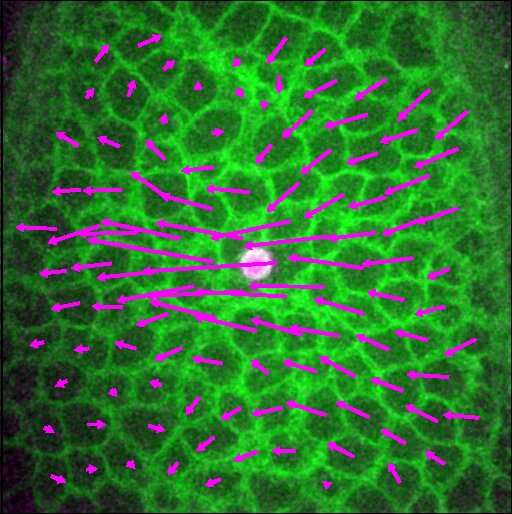Researchers design a new method to probe tissues in living organisms

The formation of the embryo, from its very early stages of development, is a complex choreography that is still a mystery to science. How each cell forms, and how tissues develop correctly are processes ruled by biochemical signals, but also by mechanical signals.
Whereas biochemical signals have been studied in depth, mechanical signals have remained unexplored for a long time due to the lack of methodologies capable of monitoring or affecting forces locally. Now, a team of scientists at the Centre for Genomic Regulation (CRG), which is part of the Barcelona Institute of Science and Technology (BIST), led by Jérôme Solon and collaborators have developed a new method to address the self-organisation of embryonic development in animals. The methodology they have designed allows them to manipulate forces and to understand how cell or tissue mechanics can change during embryogenesis.
"One of the major new developments is that we now have a method through which we can apply a force that is typically the order of magnitude that a single cell would generate, and by examining how this force deforms tissues we can ascertain how the tissue responds to this force over time," says Solon, group leader of the Biomechanics of Morphogenesis lab at the CRG and senior author of this research, published in Current Biology.
The new method would pave the way for learning more about the mechanical signals which, "together with the genetics that we know now, would allow us to join the dots: how tissues self-organize to achieve proper morphogenesis, one of the key unsolved questions in biology," adds Solon.
Mechanical forces change during embryo development. Some cells, for genetic reasons, generate certain forces locally in the embryo, whereas others are pulled or pushed by those cells. Individual cells generate forces in different ways, and the coordination of all these forces leads to morphogenesis.
"It is not an individual cell that would drive the process, it is really collective behaviour," says Arturo D"Angelo, researcher at the CRG and co-first author of the study.
"We have learned that it is important not only where the forces are generated but also how the tissue responds to them. For example, if you pull with the same force on a piece of wood or on rubber, the resulting deformation would be totally different, as would the outcome in terms of shape," explains Solon.
"With our new method, we can now address this—namely, how the mechanical properties of biological tissues can establish the deformation that the embryo will undergo," he adds. And more importantly, they have discovered that the embryo changes its material properties completely within a time range of three to four minutes.
Another key point of the study is that the new method developed by the researchers allows them to study mechanical properties in vivo, in a living organism. They do this using magnetic forces, that can be applied from a distance, without any contact, at different moments, so that the embryo is not affected.
Interestingly, the new methodology could also be applied to probe the tissue mechanics of other processes such as wound healing or cancer development, where the tumour's mechanical properties are different from healthy tissues, potentially promoting the initiation of metastasis. "Being able to measure the mechanical changes could help us to have a better understanding of how the disease develops," says Solon.
More information: Arturo D'Angelo et al. In Vivo Force Application Reveals a Fast Tissue Softening and External Friction Increase during Early Embryogenesis, Current Biology (2019). DOI: 10.1016/j.cub.2019.04.010
Journal information: Current Biology
Provided by Centre for Genomic Regulation




















